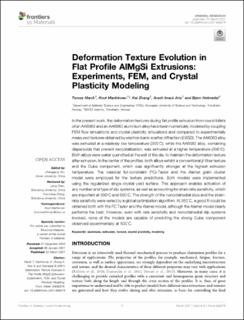| dc.contributor.author | Manik, Tomas | |
| dc.contributor.author | Marthinsen, Knut | |
| dc.contributor.author | Zhang, Kai | |
| dc.contributor.author | Imani Aria, Arash | |
| dc.contributor.author | Holmedal, Bjørn | |
| dc.date.accessioned | 2022-03-09T11:51:31Z | |
| dc.date.available | 2022-03-09T11:51:31Z | |
| dc.date.created | 2021-07-29T13:04:48Z | |
| dc.date.issued | 2021 | |
| dc.identifier.citation | Frontiers in Materials. 2021, 8 1-12. | en_US |
| dc.identifier.issn | 2296-8016 | |
| dc.identifier.uri | https://hdl.handle.net/11250/2983999 | |
| dc.description.abstract | In the present work, the deformation textures during flat profile extrusion from round billets of an AA6063 and an AA6082 aluminium alloy have been numerically modeled by coupling FEM flow simulations and crystal plasticity simulations and compared to experimentally measured textures obtained by electron back-scatter diffraction (EBSD). The AA6063 alloy was extruded at a relatively low temperature (350°C), while the AA6082 alloy, containing dispersoids that prevent recrystallization, was extruded at a higher temperature (500°C). Both alloys were water quenched at the exit of the die, to maintain the deformation texture after extrusion. In the center of the profiles, both alloys exhibit a conventional β-fiber texture and the Cube component, which was significantly stronger at the highest extrusion temperature. The classical full-constraint (FC)-Taylor and the Alamel grain cluster model were employed for the texture predictions. Both models were implemented using the regularized single crystal yield surface. This approach enables activation of any number and type of slip systems, as well as accounting for strain rate sensitivity, which are important at 350°C and 500°C. The strength of the nonoctahedral slips and the strain-rate sensitivity were varied by a global optimization algorithm. At 350°C, a good fit could be obtained both with the FC Taylor and the Alamel model, although the Alamel model clearly performs the best. However, even with rate sensitivity and nonoctahedral slip systems invoked, none of the models are capable of predicting the strong Cube component observed experimentally at 500°C. | en_US |
| dc.language.iso | eng | en_US |
| dc.publisher | Frontiers | en_US |
| dc.rights | Navngivelse 4.0 Internasjonal | * |
| dc.rights.uri | http://creativecommons.org/licenses/by/4.0/deed.no | * |
| dc.title | Deformation Texture Evolution in Flat Profile AlMgSi Extrusions: Experiments, FEM, and Crystal Plasticity Modeling | en_US |
| dc.type | Peer reviewed | en_US |
| dc.type | Journal article | en_US |
| dc.description.version | publishedVersion | en_US |
| dc.source.pagenumber | 1-12 | en_US |
| dc.source.volume | 8 | en_US |
| dc.source.journal | Frontiers in Materials | en_US |
| dc.identifier.doi | 10.3389/fmats.2021.636379 | |
| dc.identifier.cristin | 1923016 | |
| dc.relation.project | Norges forskningsråd: 309584 | en_US |
| cristin.ispublished | true | |
| cristin.fulltext | postprint | |
| cristin.fulltext | original | |
| cristin.qualitycode | 1 | |

